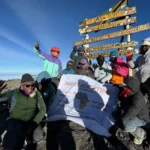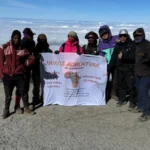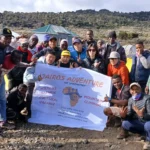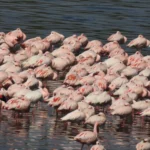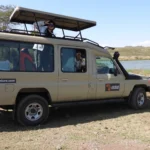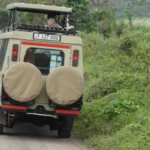Ngorongoro Crater
The Ngorongoro Conservation Area (NCA) was recognized as a UNESCO World Heritage in 1979 for its global importance in biodiversity conservation, including threatened species, wildlife density, and annual migration of wild animals. The area’s cultural recognition is based on a long sequence of evidence related to human evolution and environmental dynamics. Initially established as a multi-land use area, NCA supports wildlife coexistence with Maasai residents.
Ngorongoro Climate
The Ngorongoro Crater has a mild, temperate climate with a wet season and two rainy periods. It experiences short rains from November to December and long rains from March to May. The crater is accessible year-round, with the dry season ideal for game viewing and the wet season for grazing with predators. Warm clothing is necessary for early morning game drives. More detail about Ngorongoro weather
Getting there
Ngorongoro can be accessed by both road and air. By road, tourists travel about 160km taking roughly 2 hours to get to Ngorongoro from Arusha. A 4 Wheel drive vehicle should be used. By air, tourists can access Ngorongoro by flying from Kilimanjaro International Airport to any of the airstrips in Ngorongoro area.
There are a number of accommodation facilities in Ngorongoro that tourists can stay in, ranging from luxury, midrange to budget options. All campsites in Ngorongoro except Simba are classified as special where tourists are required to come with all the facilities needed for they are designed for self-sufficient safari goers. Luxury lodges like Ngorongoro Crater Lodge and Ngorongoro Forest Tented Lodge are a great option for those travellers after extreme comfort and excellent service.
Ngorongoro Crater Attractions
Ngorongoro Conservation Area is a protected UNESCO World Heritage Site in the crater highlands area of Tanzania. Ngorongoro is located 180km west of Arusha. Ngorongoro derives its name from the Ngorongoro crater found in the area. Ngorongoro, established in 1959, covers a total area of 8,292 square kilometres. Ngorongoro is part of the Serengeti ecosystem, and adjoins Serengeti National Park to the northwest, with the Serengeti plains in the south. The eastern boundaries of the Ngorongoro are defined by the rim of the East African Rift Valley wall.
Ngorongoro Crater
The Ngorongoro Crater is the world's largest intact and unfilled volcanic caldera and the Ngorongoro Conservation Area's main tourists’ attraction.
Empakai Crater
The Empakaai crater is one of the multi-volcanic calderas in the Ngorongoro Conservation Area, probably with the highest rim of all and a beautiful lake that makes up more than 75% of its crater floor.
Olmoti Crater
Olmoti Crater is situated at the northern end of the Ngorongoro Crater, from where Mount Lolmalasin, Tanzania's third tallest mountain, can be viewed. Gorgeous wild and lonesome landscapes emerge as they
Big five
The big five can be spotted in Ngorongoro, one of the few Tanzania national parks from where tourists can see all of them in one place. The big five include lions, elephants, leopards, buffaloes and the rhinos.
Birdlife in Ngorongoro
There are a variety of bird species in Ngorongoro that birders can see while on a bird watching activity. Some of the bird species include yellow wagtails, saddle-billed storks, ostriches, Kori bustards, lesser flamingos among so many others.
The wildebeest migration
Around January each year, the migration will be finishing a southward trek, moving along the eastern edge of the Serengeti and into the Ngorongoro Conservation Area. Here the plains are rich in nutritious grass, providing the herds with the best conditions for raising their newborn calves.
Laetoli Footprints
Laetoli is one of Africa's most important palaeontological sites. It is located on the southern edge of the Serengeti Plains within the Ngorongoro Conservation Area
Laetoli Footprints
Laetoli is one of Africa's most important palaeontological sites. It is located on the southern edge of the Serengeti Plains within the Ngorongoro Conservation Area
Laetoli Footprints
Laetoli is one of Africa's most important palaeontological sites. It is located on the southern edge of the Serengeti Plains within the Ngorongoro Conservation Area
Activities
In NCA, tourists are admired by numerous activities attached to natural and cultural attractions, areas of archaeological interest, mountains, culture and arts and festivals and events.











